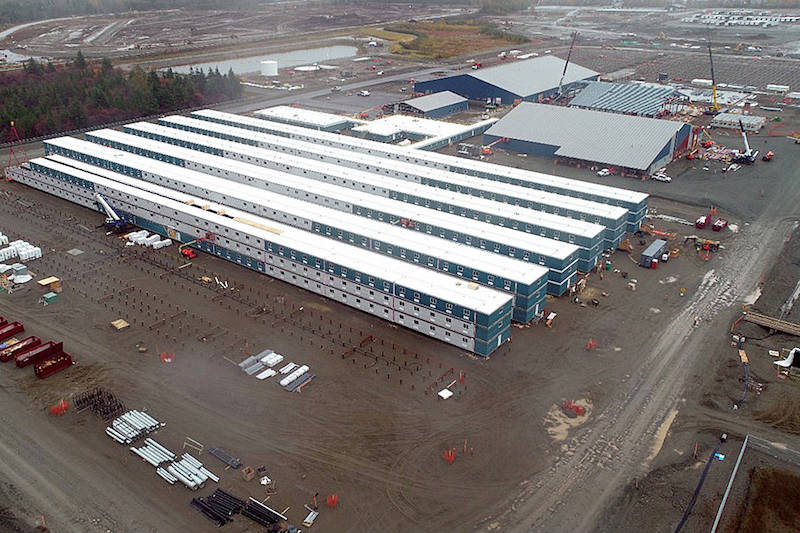The federal government’s $1-billion COVID-19 response includes $100 million to help Indigenous communities, but details and timing remain unclear.
So Alex Mirhashem, executive director for the Taku River Tlingit First Nation, isn’t waiting. He planned to drive two hours from his home in Atlin on the weekend in search of basic supplies for the community such as hand sanitizer.
“I’m going to Whitehorse myself to see if I can find anything that will help us in bulk,” Mirhashem said Friday. “If I have to buy the machine that dispenses hand sanitizer, I will do that. I haven’t gotten anything here yet. Not even a box of napkins has come through the door.”
The town of about 500 people is located in B.C.’s far northwest, near the Yukon border. While its isolation provides an opportunity to prepare for the pandemic or even prevent its arrival altogether, Mirhashem fears it could spread quickly if introduced to the community.
“If it ever breaks down here, because we are a very small and tight community, I think it’s going to spread quite fast,” he said, adding that he worries for the nation’s high percentage of Elders. COVID-19 presents a greater risk to older adults and those with chronic medical conditions.
On Monday, provincial health officials confirmed 30 new cases in B.C., bringing the total to 103. Of those, two are self-isolating in the province’s north after returning from travels and being diagnosed in Vancouver. At press time, no cases had been diagnosed in the Northern Health Authority.
As the pandemic gains steam throughout Canada, remote regions and Indigenous communities face unique challenges in stopping its spread. Access to food, clean water, medical equipment and health care staff are all a concern should COVID-19 take hold in remote areas. The spread could also be hastened by overcrowded housing, which also makes self-isolation impossible for people who test positive for the virus.
In addition, there are fears work camps that house thousands of workers in rural areas — many of whom fly in and out on a regular basis — may add pressure to local health care services.
B.C.’s Provincial Health Officer Dr. Bonnie Henry said her office is working closely with the First Nations Health Authority (FNHA) on “pieces that are unique to remote communities.”
“The impacts can be potentially so much greater if you do have cases or an outbreak in a smaller community. So, we are putting in contingency plans,” she said.
However details of those plans are unclear. The Tyee reached out to both the Northern Health Authority and the Ministry of Health on multiple occasions but has not received information about how the province is addressing the unique challenges of living remotely or what supplies are on their way to the north.
Similar questions are being raised in the House of Commons.
On Thursday, Charlie Angus, NDP MP for Timmins-James Bay in northern Ontario, questioned Indigenous Services Minister Marc Miller about the federal government’s response to the coronavirus.
“Two months into this crisis, isolated First Nations are waiting for the basics like hand sanitizers and gloves and masks, let alone ventilators,” Angus said. “If COVID-19 hits a community like Bearskin Lake or Kashechewan, we are in a nightmare scenario. Because how do you self-isolate in a home of 20 people full of mold?”
“When are we going to see a sense of urgency to protect the lives of First Nation people?”
Niki Ashton, NDP MP for Churchill-Keewatinook Aski, also sounded the alarm about issues like no running water, no hospitals and overcrowding due to lack of housing on First Nation reserves, describing the government’s current plans as “First World responses to a Third World reality.”
“This government needs to get real about what First Nations are experiencing on the ground. These communities need urgent infrastructure now and before the winter road season shuts down,” she said. Many remote communities rely on ice roads for access and will soon be cut off due to spring breakup.
In 2009, First Nations in northern Manitoba were hit especially hard by H1N1. At the time, the federal Conservative government was criticized for responding by sending body bags to the communities.
Miller has said the federal government is dealing with overcrowding on reserves by preparing to send isolation tents to remote areas, a move that has been criticized given northern climates.
Dr. Shannon McDonald, deputy chief medical officer with B.C.’s First Nations Health Authority, said it’s working to get federal funding for hotel rooms that could be used for self-isolation in some northern communities.
Late last week she said she was still waiting to hear how federal funding would be distributed.
“The funding that the prime minister announced, the $1 billion, there is a significant portion of that that’s being set aside for Indigenous communities,” McDonald said. “But we haven’t seen the breakdown yet on what the plan is for that money.”
“We’ve been working with both our federal and provincial partners around accessing more personal protective equipment, for example masks, gloves, gowns, that sort of thing.”
McDonald said the authority has made a “significant” request for provincial funding to support communities in their own pandemic planning and response capacity and pay for nursing services and emergency medical supplies.
It’s still awaiting a response, she said.
McDonald added that being remote offers an opportunity to “flatten the curve” by using preventive measures to spread demand for medical professionals and equipment over a longer time period — something that will be necessary to ensure enough resources for those needing medical attention.
On Friday provincial Health Minister Adrian Dix reported on resources available to each of the province’s five regional health authorities. Northern Health is home to 300,000 people, or roughly six percent of the population. Out of 8,602 acute care beds available provincially, about six per cent are in the north.
About nine percent of the province’s 1,272 ventilators, or 116 units, are spread over Northern Health Authority, which covers two-thirds of the province. Ventilators are needed to help the most seriously ill people breathe.
Additional ventilators are being ordered, Dix said. He did not say how many, when they might arrive or where they would be allocated.
Dr. Lothar Schaefer, a retired anesthetist in Smithers, said limiting the pandemic in the north will depend on how efficiently testing and transporting patients take place.
“The critical thing will be when people come in who are in need of respiratory support,” he said.
Schaefer said smaller facilities, like the 25-bed Bulkley Valley District Hospital in Smithers, are a stopgap for patients needing ongoing care. Emergency rooms can ventilate patients for a short time, he said, but will need to quickly transfer patients to larger centres like Prince George, Prince Rupert, Terrace or the Lower Mainland.
“We don’t have the staff in hospital to manage ventilated patients,” Schaefer said. “The more you can slow it down, the better it’ll be for the health care system.… The system will be taxed when it really hits.”
Frequent handwashing, increased social distancing and self-isolating as soon as any symptoms occur has become the mantra from health officials.
Smaller communities like Atlin rely on health centres staffed by nurses and visited by doctors only once or twice a month.
McDonald said plans are being made to maintain health care staff numbers even as some fall ill after being exposed to the virus. “It will be challenging, I think, because everybody will be on the search for the same thing.”
An important part of slowing the virus’s spread is early testing followed by self-isolation for positive cases. While test results are available within several days in southern B.C., transporting samples to labs in the Lower Mainland slows the process in the north.
“If you do a swab in Atlin or Gitxsan territory or wherever you happen to be, those have to be transported, usually to a health authority lab, and then are sent with the health authority lab requests to the central lab and then the results have to go back,” McDonald said. “So you may get a presumptive test within two days — maybe — but the confirmatory test could take longer.”
One Smithers health clinic has cautioned that tests could take a week and is asking patients to self-isolate while awaiting results.
Across B.C., 14 First Nations are also subjected to water advisories. McDonald said that while the advisories are concerning, they aren’t expected to impact attempts to fight COVID-19.
“Wherever there are water advisories, there is supplied clean drinking water. We’ve upped the amount that might be available because of the increased need for handwashing. In communities where there is a boil-water advisory, boiled water can be used for washing appropriately,” she said, adding: “It’s not ideal, absolutely.”
McDonald said some northern communities are concerned about how work camps — some of which house thousands of workers — could flood health care facilities in nearby communities. She said she shared the concerns with Northern Health and is asking companies to stock their camps with medical supplies.
“We need to be aware of that, we need to plan for that, and we need to work with those industrial partners to say, you need to up your game,” she said.
On Friday, LNG Canada posted plans to deal with the virus in remote camps on its website. “We continue to meet with our project partners and with the Northern Health Authority to ensure we are aligned and effective in our approach to the COVID-19 outbreak,” the statement said.
McDonald said the First Nations Health Authority has also been working with communities on their communicable disease plans, some of which date back to the H1N1 outbreak more than a decade ago and may need to be updated. The authority is also working with them to ensure emergency supplies are in place.
“If we can stretch out that curve so that it doesn’t overwhelm the health system at any particular point, that’s our goal,” McDonald said. Cancelling events, such as Kelowna’s Junior All-Native Basketball Tournament, is a disappointing but necessary step.
“There may not be an immediate risk to the young people who would have gone, but they all eventually go home to their communities,” she said. “They may have an asymptomatic infection or a very mild infection, because many of them are young and healthy and that’s the likelihood. But they could carry that virus home to the Elders and those with compromised immune systems or chronic disease who would be much more at risk.
“We’re hoping that the majority of our communities are never impacted. That is the goal.”
Up in Atlin, Mirhashem said they are in regular communication with FNHA and are doing all they can to get ahead of the illness — including informing the community about good hygiene and looking into making their own hand sanitizer.
“We are taking precautions. I’ve talked to staff myself about washing your hands, sanitizing and all those things,” he said. “When you live in a remote area, there’s not many options.” ![]()
Read more: Indigenous, Health, Coronavirus

















Tyee Commenting Guidelines
Comments that violate guidelines risk being deleted, and violations may result in a temporary or permanent user ban. Maintain the spirit of good conversation to stay in the discussion.
*Please note The Tyee is not a forum for spreading misinformation about COVID-19, denying its existence or minimizing its risk to public health.
Do:
Do not: